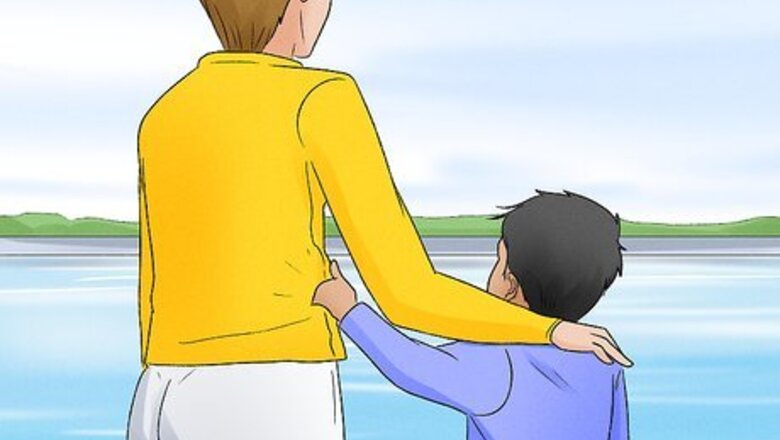
views
Water Introduction
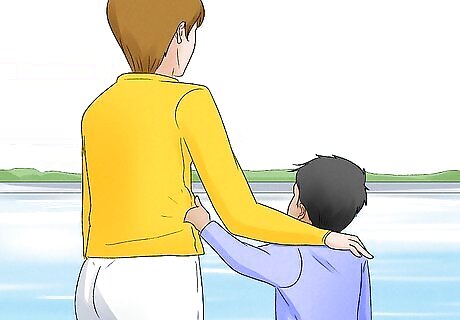
Remind your kiddos not to run and to stay close to you. Set a few firm ground rules with your little one before taking them to the water. Instruct them not to run near the edge of the water, and not to go into the water unless a trusted adult is nearby. For example, you can say something like, “Don’t get into the water until Mommy or Daddy says it's okay.” Never leave your little one near the water without supervising them.
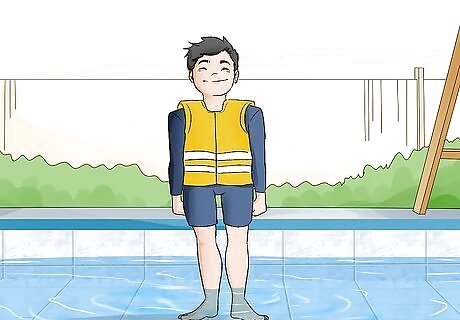
Offer your little one a life jacket for safety. Inflatable floaties and swimsuits aren’t actually that great—they can deflate pretty easily, which can be super dangerous. Instead, strap your child into a life jacket, which will provide a lot of extra support while they’re getting used to the water. Look for life jackets certified by an established organization, like the Coast Guard.
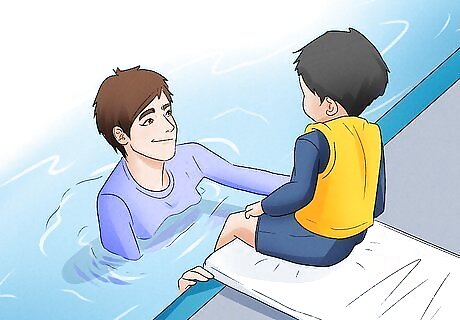
Guide your child into the water with a pad. Lay a pad or towel along the side of the shallow end of the water, and place your little one along the edge. Once your child is secure, get into the water yourself, and stand 2 to 3 ft (0.61 to 0.91 m) in front of them. Encourage the child to shift off the pad and climb into the shallow end of the water, while you provide as-needed support. When your child gets in the pool, carry or guide them through the water so they stay afloat. Every child is different—if your little one is pretty confident, you may not need to help them out very much as they climb into the water. If they’re a little unsure, provide a little extra support and encouragement. Don’t “walk” your child down the steps into the water, as they might slip on the way down.
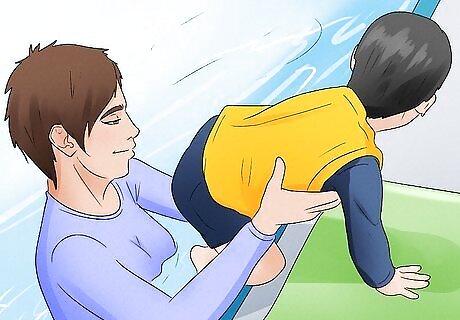
Help your toddler learn how to get out of the water with a pad. Place a pad along the outside of the pool. Lift up your little one so they can grab and climb onto the side wall. Encourage them to climb up and onto the pad, so they‘re completely out of the water. Don’t place your child on the pad right away. Instead, encourage them to climb up and out of the water on their own, while you hold onto their hips for support.
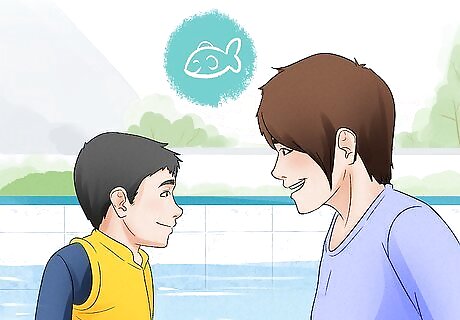
Encourage your kids to “talk” to the fish so they’re used to the water. The water can be intimidating for little tikes, especially if they’ve never taken a dip before! Carry your child into the water and teach them to blow bubbles into the water as a way to “talk” to the fishies down there. Then, help them place their ear along the water to “listen” for a response. Always look happy and excited as you’re blowing bubbles in the water. This will help your child feel a lot more encouraged and confident!
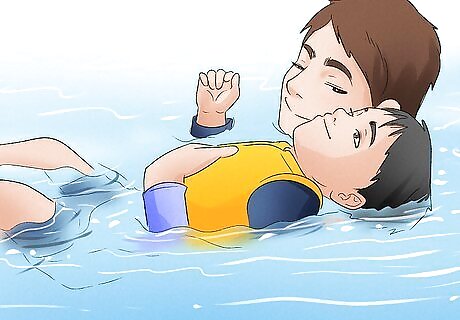
Teach your little one how to float on their back. Help your child shift onto their back, letting their head lean against your chest. Invite them to spread their arms out in “T” shape, and gradually move their head off your chest. Support their back with your hands, slowly removing your fingers until your little one is floating on their own. You’ll need to practice floating a lot before your child really gets the hang of it.
Breath Holding
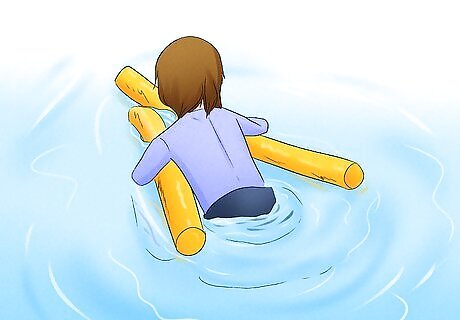
Wait until your child seems comfortable in the water. Dunking underwater for the first time is a big milestone, but you don’t want to rush your child into it. Spend time with your child in the water, and see how confident or nervous they feel. It can take a little time before your child feels ready. Provide with lots of support and encouragement whenever they’re in the water! You can always start simple, like teaching your child to hold their breath in the tub! Goggles and nose plugs might make dunking underwater a little less scary for your little one.
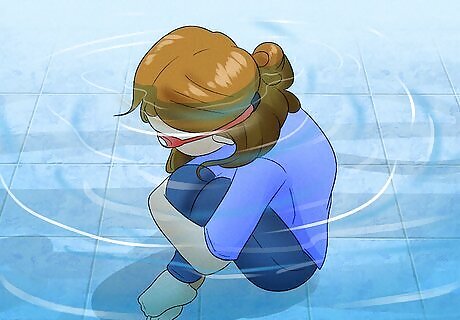
Teach your little one how to hold their breath so they don’t breathe in any water. Hold onto your little one in the shallow end of the pool. Invite your child to touch your tummy while you take a big, deep breath and hold it in. Puff out your cheeks like a squirrel so your child can understand how to hold their breath.
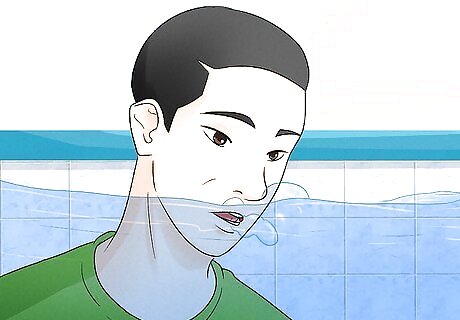
Show your toddler how to exhale. Count to 3 with your fingers while holding your breath. Sink yourself down in the water so your mouth is around water level, and then exhale onto the water. This will create some bubbles, and help your little one learn how to release their breath after they’ve held it in. If your child doesn’t quite understand, encourage them to blow bubbles in the water. This is a great way to get the hang of breathing out, and understanding what it looks like.

Demonstrate a few deep breaths for your child. Take a couple of deep breaths, touching your nose with your fingertip while you inhale. When you breathe out, make a dramatic “motorboat” noise to show where the air is going. Don’t gasp for air—instead, take long, steady breaths, so your child realizes that holding and releasing a breath is perfectly normal.
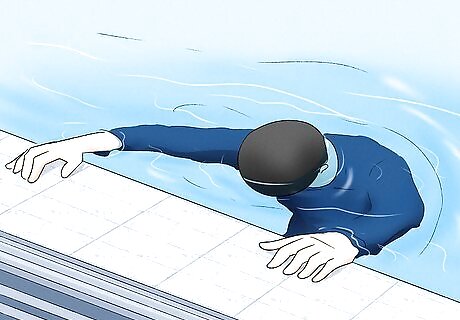
Dunk under the water yourself so your toddler understands what to do. Take a deep breath and puff out your cheeks before you dunk, and then pop under the water for several seconds. Stay underwater for a couple seconds, keeping your cheeks puffed out, and then return to the surface. Remind your child that it’s important to hold your breath before going underwater, so you don’t get any water in your nose or mouth—once they’re out of the water, they can release the breath. For example, you can say something like, “Mommy’s gonna dunk under the water for a few seconds. Can you count to 3 for me?”
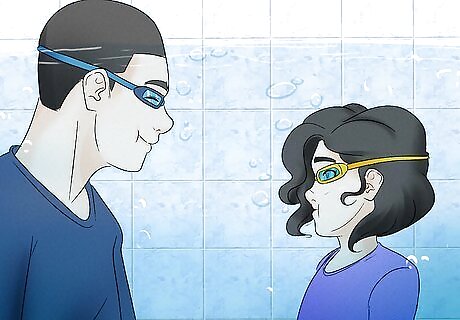
Go under the water with your child for a few seconds. Let your little one know that you’re both going to dunk under the water together. Remind your child to hold their breath and close their eyes, keeping their cheeks puffed out like a squirrel. Look at your child as you dunk them both under the water for a few seconds. Then, bring them back up to the surface. Try to stay underwater for at least 3 seconds, so your little one can get used to the water.
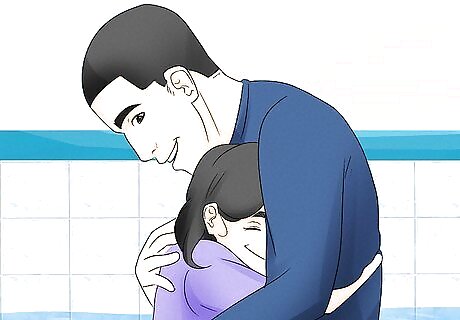
Shower your little one with lots of praise and reassurance. Dunking in the water can be really scary for some children, so let them know that you’re super proud of them, and that they did a great job. Offer tons of encouragement and reminders that they’re perfectly safe,
Simple Treading
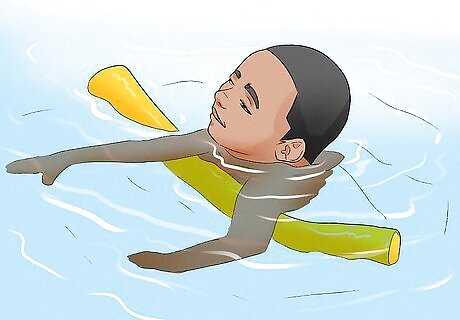
Place a pool noodle under your child’s arms. Guide your little one into the shallow end of the pool. Lift up their arms, and stick a pool noodle underneath—this will help them float on their own while they learn to tread water.
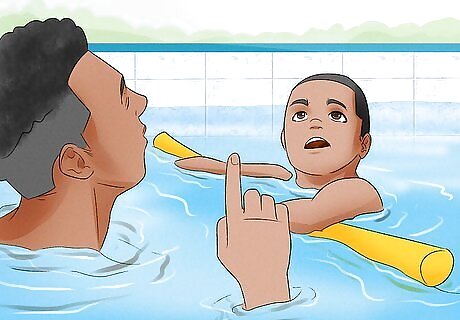
Encourage them to look up and turn in a circle. Point towards the sky or ceiling, and coax your child to look upwards. When they’re treading water, you don’t want their head sinking beneath the surface.
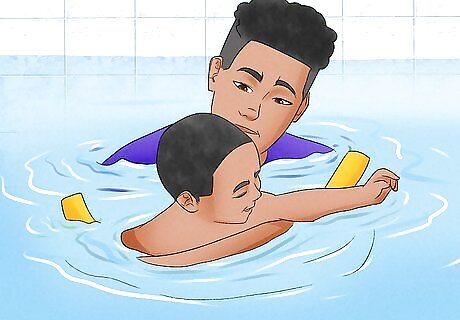
Guide your toddler's hips to help them turn. Give your little tike a lot of encouragement, telling them to turn themselves in a circle. Place your hands lightly on your child’s hips to help them get the hang of spinning in the water. Don’t spin them too much—just enough so they get the hang of what’s going on.
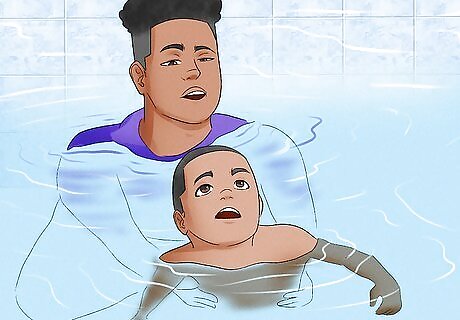
Remove the noodle and encourage your child to keep turning. Once your child seems really confident and happy in the water, ask them if you can take away the noodle for a little bit. Encourage them to keep turning in a circle, so they stay afloat in the water. Continue supporting your child’s hips as they turn, so they can build up their confidence in the water. Stay really close to your little one as they do this. Even if they’re spinning on their own, you want to provide support close by.
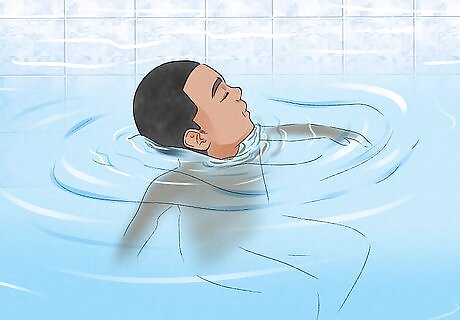
Let go of your little one gradually as they feel more confident. Ask your little one how they’re feeling, and if they’re ready to try spinning on their own. If your child seems very happy, confident, and independent, let go of their hips and let them spin themselves around in the water without any help. Don’t rush your child into this! They may need a lot of extra support before they’re ready to tread water on their own.
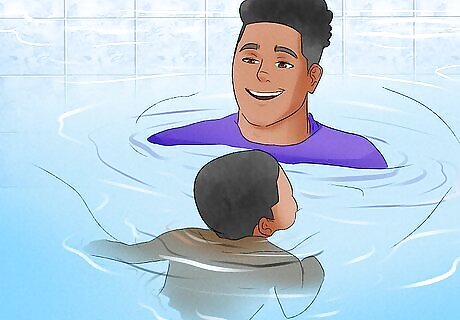
Work up to having your kiddo tread water for 1 minute. Stand close to your child while they spin and tread water. Shower them with lots of praise, encouraging them to keep spinning in the water. See if they can make it to the 1-minute marker—if not, that’s perfectly okay! You can work with your child on gradually treading water for longer periods of time.
Basic Swimming Skills
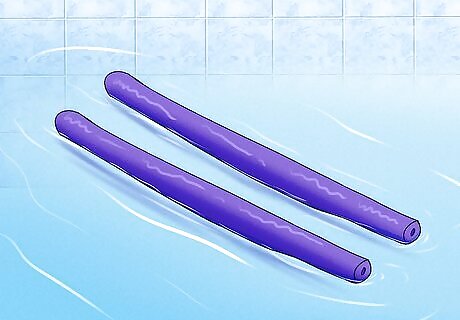
Use 2 pool noodles to help your child learn to kick and paddle. Bring your little one to the shallow end of the pool, and place 2 small pool noodles beneath their armpits. Lightly hold onto the ends of the pool noodles, encouraging your child to kick and paddle to move themselves through the water. You can move your child’s arms through the water first so they get an idea of what to do.
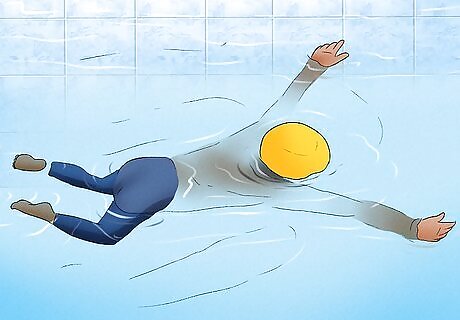
Teach your child to paddle by encouraging them to “catch fish.” Sit along the shallow side of the pool, where your little one can stand comfortably without going under the water. Place them in front of you and tell them to reach forward and “catch” the fish in the pool by swinging their arms forward in a windmill motion, like a front crawl. Encourage your kiddo to pull the water toward themselves so they can get the hang of the paddling motion. Sing a little tune with them while they paddle their arms, and see how many “fish” your little one caught at the end. For some extra fun, tell your child to toss the fish they caught back into the water.
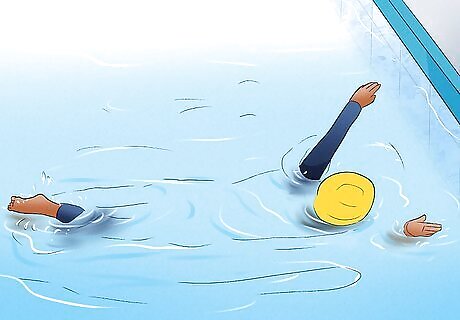
Play “red light green light” to teach your toddler to kick their legs. Go to the shallow side of the water with your little one. Encourage them to hold onto the steps or side of the pool, while keeping their head above water. When you say “green light,” encourage your child to kick their legs behind them as fast as they can. Once you say “red light,” encourage your child to stop kicking. If your little one is pretty confident in the water, give them a kickboard to hold onto.
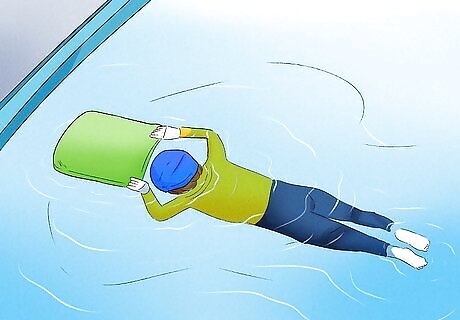
Encourage your child to swim a short distance to the wall. Sit in the shallow end of the pool and kneel into a sitting position, about 3 ft (0.91 m) or so from the wall. Lift your child and have them stand on your thighs. Tell them to “jump” off your legs into the water, and then swim over the wall. If needed, you can give them a little extra support along the way. Give them a few seconds to really grab onto the wall and support themselves, so they get used to swimming towards the water’s edge.
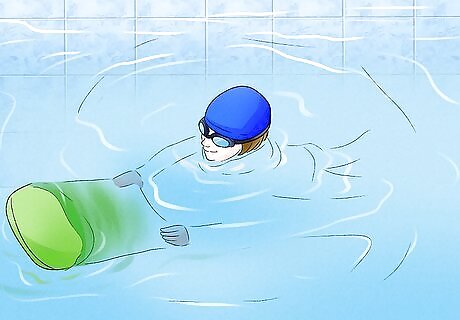
Help your little one swim on their own with a support. Give your child a kickboard or other flotation aid they can hold onto while in the water. Encourage them to swim a short distance on their own by kicking their legs behind them. This is a great way for your little one to get the hang of kicking in the water.
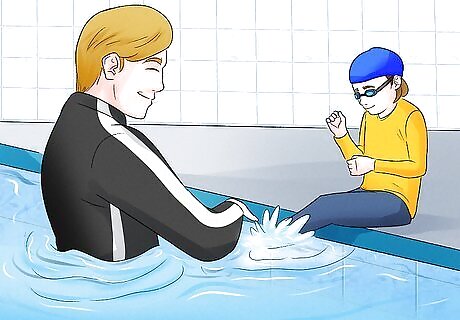
Teach your child how to do a freestyle stroke. Sit your child on the pool steps and encourage them to kick their legs in front of them. Then, guide your little one into the water and show them how to swing their arms forward. Once they seem comfortable with both of these movements, try putting everything together! Encourage your little tike to kick behind them while moving their arms, so they can get the hang of the stroke. You may need to give your child some guidance on when to breathe. For instance, every 3-5 strokes, remind your child to “breathe,” and lift their head out of the water for a moment. Learning a new swimming stroke takes a lot of time and effort. It may take weeks, months, or years before your little one really gets the hang of it.
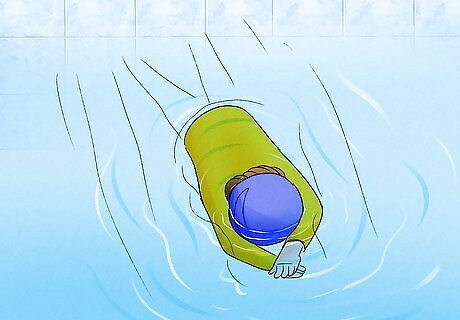
Encourage your child to swim a short distance on their own. Stand next to your child in the water and encourage them to swim across part of the pool, for about 25 yd (23 m). Remind them to swim towards an exit, where they can climb out of the pool on their own. If your child is still getting used to the basics, encourage them to swim a shorter distance.













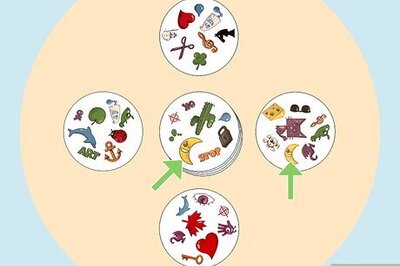






Comments
0 comment